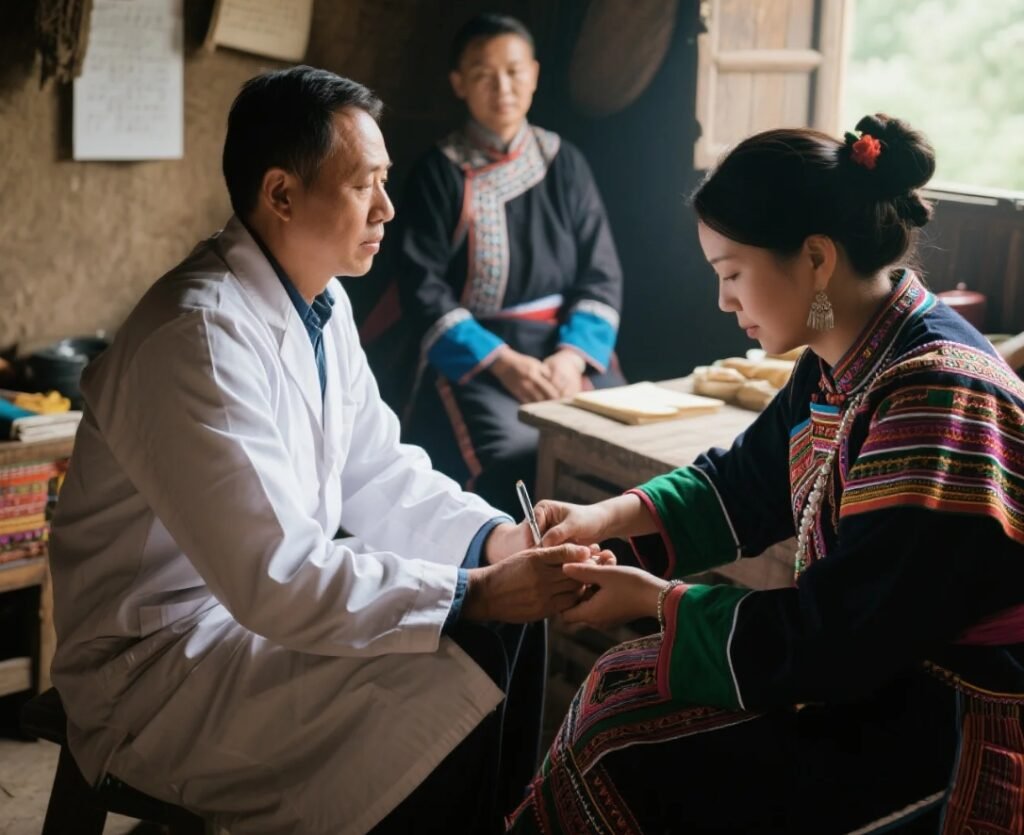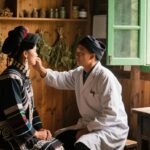Jian Wu Pu Xiang ( Ruyong / Acute Mastitis)
Overview
In Miao medicine, acute mastitis is called Jian Wu Pu Xiang, also known as Jian Wu Meng. It most often arises from poor maternal hygiene, inadequate infant oral care, cracked nipples or milk stasis, which allow pathogenic heat‑toxin to invade the breast. In Traditional Chinese Medicine, Ruyong presents with breast nodules, swelling and pain accompanied by systemic fever; after abscess formation and ulceration, thick pus discharges. It occurs chiefly in lactating women, especially primiparas within the first postpartum month. In Western medicine, acute mastitis likewise manifests as a painful, swollen breast nodule with fever and other systemic signs in breastfeeding women within one month after delivery; diagnosis and management may follow similar principles.
Classification in Miao-Medicine
Jian Wu Pu Xiang is regarded as a major disease under the category of Re Jing Re Bing (Heat‑Channel Heat Diseases) and is divided into the Red‑Swelling Stage and the Ulcerative Stage.
Etiology
Poor maternal hygiene, inadequate infant oral hygiene, nipple fissures or milk accumulation allow heat‑toxin to opportunistically invade the breast tissue.
Pathogenesis
Invasion of heat‑toxin into the breast obstructs local Qi and blood circulation, causing distension and pain.
Diagnostic Criteria
Predominantly affects breastfeeding women within the first month postpartum, especially those with nipple cracks or milk stasis.
Milk‑Stasis Stage: sudden swelling, distension and pain of one breast, sometimes with a hard mass (or none), typically in the outer lower quadrant; difficulty expressing milk; systemic fever, chills, headache, body aches and anorexia. With appropriate (used in traditional contexts), fever subsides and pain eases within 2–3 days, indicating likely (supports).
Suppurative Stage: worsening of previous symptoms, enlargement of the hard mass, overlying skin becomes red and hot, pain is throbbing with tenderness, ipsilateral axillary lymphadenopathy and persistent high fever—signs of abscess formation. A central softening with fluctuation indicates a mature abscess; deep abscesses may require aspiration for confirmation.
Ulcerative Stage: spontaneous rupture or surgical drainage relieves swelling and pain, fever abates and healing ensues. Poor drainage with persistent pain and fever may lead to loculated abscesses, infection of adjacent lobules (“transmammary pain”), or septicemia. Chronic draining with milk leakage may result in a persistent milk fistula.
Differential Diagnosis
Breast nodules caused by cyclical Qi–blood stagnation (menstrual mastalgia) present with cyclic swelling and pain modulated by emotions and menses, without fever or pus. Breast cancer presents as a hard, fixed, often painless mass with skin dimpling or nipple changes in older women—distinguished from the acute, febrile, suppurative course of Jian Wu Pu Xiang.
Stage‑Based Treatment
1. Red‑Swelling Stage (Hong Zhong Qi)
Presentation: sudden chills, fever, swelling, hardness, redness and pain of the affected breast with palpable nodules.
Treatment Principles: clear heat and detoxify, reduce swelling and relieve pain.
Formula:
Viola yedoensis (Zi Hua Di Ding) 20 g
Taraxacum mongolicum (Pu Gong Ying) 20 g
Three‑Needle Herb (San Ke Zhen) 15 g
Solidago canadensis (Yi Zhi Huang Hua) 15 g
Decoct in water and administer orally.
Zi Hua Di Ding is cold, bitter, enters the heat channels, clears toxin and reduces swelling; Pu Gong Ying is cold, slightly bitter, stops pain and dissipates accumulations; San Ke Zhen is cold, bitter, clears heat, drains dampness and detoxifies; Yi Zhi Huang Hua is cold, bitter, enters the heat channels with slight toxicity, disperses wind‑heat, clears toxin and reduces swelling.

2. Ulcerative Stage (Kui Lan Qi)
Presentation: breast is hot, red, swollen, discharging pus, with distension, chills, fever, nausea, dizziness, anorexia and constipation.
Treatment Principles: clear heat, detoxify, disperse stasis and relieve pain.
Formula:
Lonicera japonica (Jin Yin Hua) 20 g
Patrinia villosa (Bai Jiang Cao) 20 g
Decoct in water and administer orally.
Jin Yin Hua is cold, sweet and slightly astringent, clears heat and toxin, cools blood; Bai Jiang Cao is cold, bitter and astringent, removes stasis and drains pus.
Preventive Care
- From five months’ gestation onward, (traditionally used for digestion) nipples regularly with warm water or 75 % ethanol; for inverted nipples, perform manual eversion and lifting, or use a small cup suction.
- Instruct mothers in scheduled breastfeeding to maintain unobstructed milk flow; if milk oversupply occurs, use a breast pump to fully express.
- Keep nipples clean; treat fissures or abrasions promptly.
- Ensure infant oral hygiene; do not allow infants to sleep with the nipple in their mouth.
- Mothers should maintain emotional well‑being; wean gradually by reducing feeds before cessation.
Commentary
Miao-medicine attributes this condition to Qi–blood stagnation and accumulated heat‑toxin in the breast channels, resulting in obstruction and pain. Treatment emphasizes dispersing nodules, reducing swelling, removing stasis and draining pus, with classic use of Bai Jiang Cao (Patrinia villosa), Pu Gong Ying (Taraxacum mongolicum) and Zi Hua Di Ding (Viola yedoensis) for clearing heat, detoxifying and resolving abscesses. Equally important are proper feeding hygiene and habits to (helps maintain) recurrence.



Leave a Reply